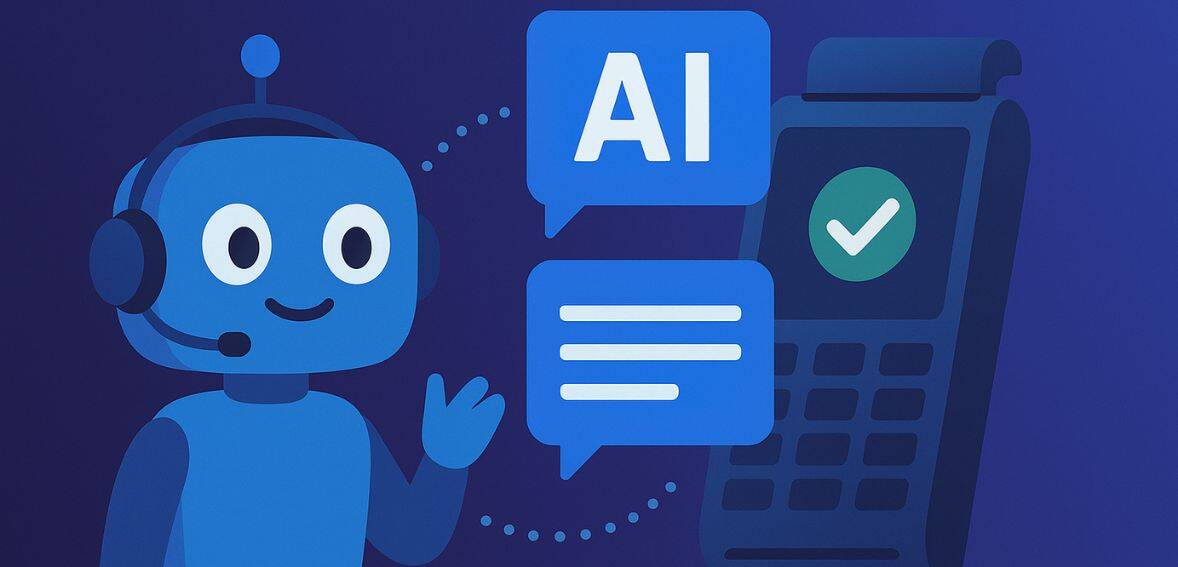
By Angie Lindquist June 19, 2025
In an era where instant gratification defines customer expectations, delays in resolving payment issues can quickly erode trust and loyalty. As digital transactions grow in speed and complexity, traditional support systems—like call centers or email queues—struggle to keep pace. Enter AI-powered chatbots: intelligent, always-on digital assistants capable of managing real-time payment inquiries with accuracy, empathy, and efficiency.
Far from their early days of scripted replies, today’s advanced chatbots can troubleshoot errors, guide users through refund processes, and interact directly with payment systems—all in a single conversation. This article explores how AI chatbots are transforming payment support, the technology driving their evolution, and how businesses can deploy them strategically to enhance customer satisfaction while maintaining security, compliance, and cost efficiency.
The Evolution of Payment Support
In the past, customer service for transactions was handled through call centers or email support, which resulted in delays that irritated agents and customers alike. Traditional support techniques frequently failed to keep up with the speed and complexity of contemporary transactions as e-commerce grew and digital payments became widespread.
Chatbots initially appeared as front-line answers to simple questions. The most sophisticated models available today, particularly those driven by generative AI, can assist users in real-time error troubleshooting, charge reconciliation, and payment decline resolution, effectively resembling expert agents without the need for human intervention.
Advanced chatbots have evolved from AI repeating prewritten responses to assisting users with multi-step procedures like card setup or refund requests by integrating with payment platforms. These systems react in the background by sending messages and actionable instructions that are integrated into the payment system, starting processes that previously needed to be started by a support agent. AI chatbots can enhance payment support with previously unheard-of speed and consistency by remaining continuously available.
Behind the Technology: How AI Enables Real-Time Payment Support

Real-time data integration and natural language processing (NLP) form the foundation of any AI chatbot. Understanding the distinction between deep learning vs machine learning is crucial for selecting the right AI architecture for payment support systems.
Even when user intent is expressed ambiguously, NLP allows the system to decode it. When a user inquires as to whether their card was declined due to merchant problems or a lack of funds, the AI is assisted by proprietary financial language models that have been trained on payment-specific terminology.
The link between the payment infrastructure and the bot is equally important. This includes having access to settlement statuses, fraud indicators, user verification layers, and real-time transaction logs. The AI can now respond contextually in ways that go far beyond static FAQs thanks to these integrations.
When a user complains about a double charge, for example, the bot can instantly check transaction timestamps, identify duplicates, and, if necessary, start a dispute or issue a refund. Intelligent payment chatbots differ from previous generations of automated agents in their ability to identify, inform, and resolve problems within a single conversation loop.
Building Trust Through Transparent AI Conversations

Trust is one of the main obstacles to using AI chatbots to assist with payments. When a bot seems unclear or robotic, users are frequently reluctant to provide financial information. Transparency in conversation becomes essential to addressing this. A chatbot should begin by using straightforward, sympathetic language when it first recognizes that a transaction has failed: “I see the payment failed due to insufficient funds.”
In order to establish credibility and reassure users that the results are not based on conjecture, the bot must always reveal how it knows what it knows, referencing transaction IDs, timestamps, and system logs. Additionally, chatbots can proactively offer to email users transaction receipts, connect them to security features, or, in the event of an urgent issue, arrange a callback. This customized follow-up shows that the chatbot is goal-driven to find a solution rather than merely reactive.
Thus, AI that has been trained with empathy becomes essential, creating responses that recognize stress, express regret for any inconvenience, and reassure users that the system is actively working on a solution. This combination of control, empathy, and transparency turns AI interactions into trust-building tools in a sensitive area like payments.
Enhancing Security and Compliance
Security and compliance issues become urgent when AI chatbots are incorporated into payment ecosystems. Sensitive user information like credit card numbers, partial SSNs, or authentication tokens may be accessible to chatbots. As fraud techniques continue to evolve in the digital economy, understanding the evolving payment fraud tactics is essential for designing AI systems that can detect and prevent modern scams.
In accordance with “least privilege” principles, access control models must guarantee that the bot only retrieves data necessary to answer a query, in addition to encryption. Comprehensive audit trails, frequent vulnerability assessments, and well-defined data retention policies for chatbot interactions are all necessary for compliance with data privacy regulations like PCI DSS, GDPR, and CCPA.
Vendors should guarantee that user transcripts are anonymized when kept on file and that users can request deletion procedures. Additionally, to ensure that chatbots do not unintentionally discriminate in their responses or service delivery, they should be subjected to routine bias audits and QA testing. Chatbots become effective and accountable stewards of financial conversations when security, compliance, and trust are all in harmony.
How Training Data Shapes Chatbot Intelligence in Payment Systems

The quality of their training has a significant impact on how well AI chatbots support payments. Payment-focused bots, in contrast to generic AI models, need ongoing training with transaction-based, highly contextual data. This entails supplying them with annotated transaction logs, past support interactions, and even sentiment indicators from customers.
In addition to understanding natural language, the chatbot should be able to understand financial nuances, such as whether “pending refund” means different things depending on the context of the payment processor or whether transaction delay patterns vary depending on the location. Additionally, supervised fine-tuning is crucial. By examining chat logs, fixing errors, and adapting for compliance language, developers must continuously improve the chatbot’s responses.
For example, when discussing regulatory account freezes or suspicious transaction disputes, a bot should be able to recognize when it needs to switch the conversation to a human. The chatbot’s knowledge keeps growing when it is combined with reinforcement learning from human feedback (RLHF).
This improves resolution accuracy and complies with data security regulations by establishing a contextually aware and responsive payment support environment. AI chatbots that receive this kind of focused training become real financial allies, able to manage complexity with agility and compliance in mind.
Behind the Scenes – AI Chatbots Working with Human Agents

Not all situations can be handled by even the most sophisticated payment chatbot. A shared escalation infrastructure is necessary in many organizations. A conversation should smoothly switch to a human agent without requiring the user to restart when a chatbot detects that a request calls for human judgment, such as in a complex fraud case or high-value dispute.
Context continuity is essential; in order to prevent wasting user time, the human reviewer needs to be able to view the transaction history and user dialogue. Strong API hooks and training for support personnel on AI-assisted workflows are necessary for this. To guarantee exchange continuity, agents should be conversant with the reasoning framework and typical conversational language used by the bot.
By automating repetitive tasks and retaining high-quality human touch points where necessary, these hybrid support setups enable businesses to cut costs while strengthening both efficiency and customer care.
Measuring ROI and User Experience
When AI-driven payment support is implemented, the benefits will go from being intuitive to having quantifiable effects. Leading KPIs include support cost per interaction, user satisfaction ratings, average resolution time, and bot containment rate (the proportion of queries handled by the bot). It is important to monitor these metrics over time and compare them to the current support channels.
Loops for user feedback improve continuous improvements: users should be asked to rate their level of satisfaction right after a problem is fixed, and the information gathered can be used to modify response tone or retrain models. For example, the system might need targeted training to access more accurate refund data if users frequently score the bot as unhelpful when it comes to chargeback inquiries.
It’s also critical to keep an eye on intent drift, which occurs when the bot misinterprets queries. The AI chatbot’s support for real-time payment is ensured by ongoing testing, validation, and performance optimization.
The Future: Smart Payment Ecosystems

In the future, AI chatbots for payments will transform from reactive instruments for resolving issues to proactive partners in transactions. They will keep an eye on user behavior and provide proactive reminders, like alerts when billing limits are approaching or notifications when a new payment method is added.
Additionally, chatbots can work in real time with sophisticated fraud detection engines to negotiate payment holds or use biometric challenges to verify user identity. Chatbots could be integrated into business dashboards on the merchant side to notify operators of significant refunds, unsuccessful batch payments, or questionable drops. These AI helpers would serve as ubiquitous security measures, enhancing consumer experiences and business operations.
The next step is to use AI, visual interfaces, and voice synthesis to create “payment concierge” experiences through in-app virtual assistants or smart speakers. AI-powered payments in 2025 and later might resemble speaking with a trusted financial advisor more than typing commands.
Conclusion
AI chatbots that provide real-time payment assistance represent a significant change in the way companies handle client communications. These solutions bridge speed, accuracy, and trust by fusing natural language capabilities, smooth system backends, and sympathetic dialogue design. The frontier is improving financial services’ communication, support, and learning processes rather than just taking the place of call centers.
Reduced support expenses, improved customer satisfaction, and a potent AI-driven feedback engine that drives ongoing improvement are all advantages for businesses that embrace this shift. Every unsuccessful transaction or unanswered question can undermine confidence in the quick-paced world of digital payments.
More than just an efficiency boost, implementing AI chatbots that identify and fix problems instantly gives businesses a competitive edge. Future real-time payment support begins now for businesses prepared to invest in encrypted infrastructure, user-centric design, and hybrid human-AI workflows.